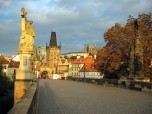The Baroque period was a time of beautiful architectural design and artistry that began in Italy. The Wallenstein Palace is an example of one such structure that was built during this time in Mala’ Strana, Prague. Built in honor of Albrecht von Wallenstein, the beautiful palace has long been an historical landmark for the city of Prague.
History
The Wallenstein Palace began the construction process in 1623. By 1630, the intricately designed palace was complete and the very wealthy Albrecht von Wallenstein had a place to call home, although it was short lived. The influential military leader began to amass so much power and wealth that a list of enemies began to pile up. The emperor at the time found Wallenstein too much of an adversary and decided to have him assassinated in 1634. Charging Wallenstein with treason, Emperor Ferdinand II eliminated his one true threat at the time. Wallenstein’s widow sold the palace to a cousin and the palace remained in the family until the mid 1900’s. The building is now the home of the Czech senate after being seized by the government in 1945.
Palace Design
The design for the palace was very ambitious at the time it was built. Wallenstein bought over 20 homes and gardens to help complete his design for the palace. The huge size of the building was comparable to the Prague Castle. The building also had lush lawns and beautiful structures all around it. The main hall of the building was adorned with expensive tapestries, huge statues and Italian designed furniture. Albrecht von Wallenstein himself is depicted on the ceiling as the Greek god Mars. In addition, the complex is complete with many wings and at one time could accommodate more than 700 people.
The Wallenstein’s exquisite garden is one of the city’s most beautiful grounds and covers more than 4 acres. Its Italian inspired layout and intricately carved sculptures have made the garden a popular attraction.
The garden of the palace also has the Sala Terrena garden pavillion on its eastern end. The loggia is nearly 100 feet tall and contains huge arches with beautiful flowers. There is also a pond that exhibits a marble fountain. The marble fountain contains a statue of the Greek god Hercules and was created by Adrian de Vries.
Palace Chapel
The legend of St. Wenceslas was the inspiration for the design theme in the two story palace chapel. Arnost Jan Heidelberger built the chapel’s altar, making it the first monument created in the Baroque style in Prague in 1630. This opened the door for the Baroque movement in the city and began the influx of intricately designed buildings and statues throughout Prague.
The Wallenstein Palace is now the home of the Czech Senate; years of restoration have made it available for sightseeing tours for tourists and locals alike. Visitors may also tour the palace garden free of charge. In 1995, the impressive palace was designated as a national cultural monument and remains an important piece of Prague history.























